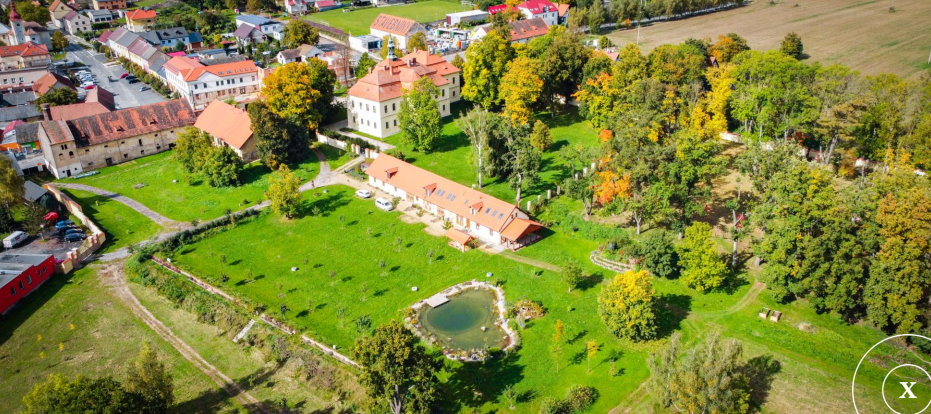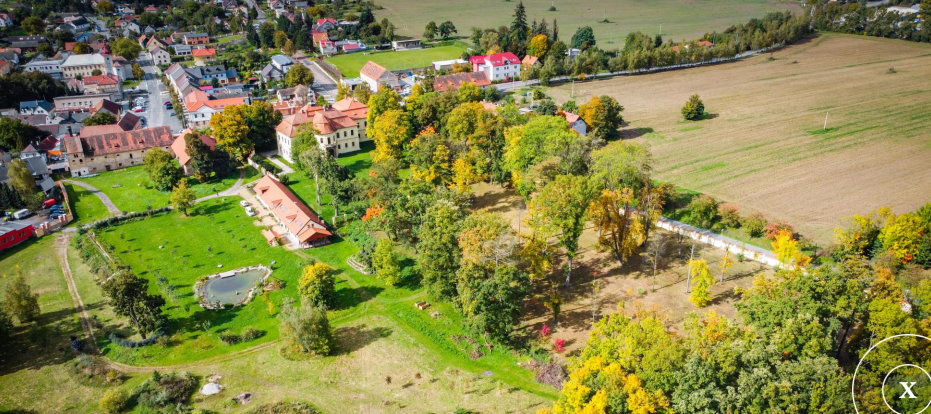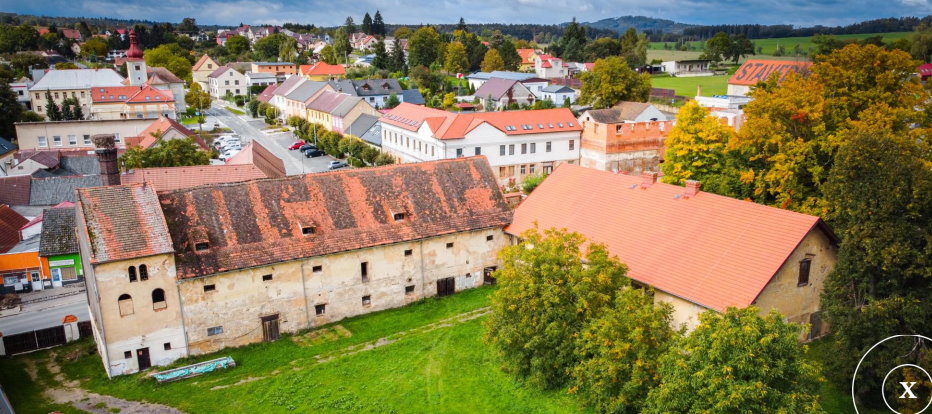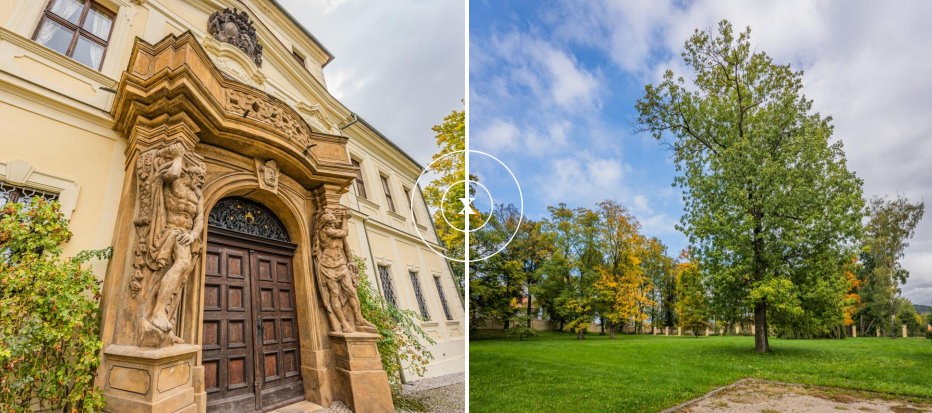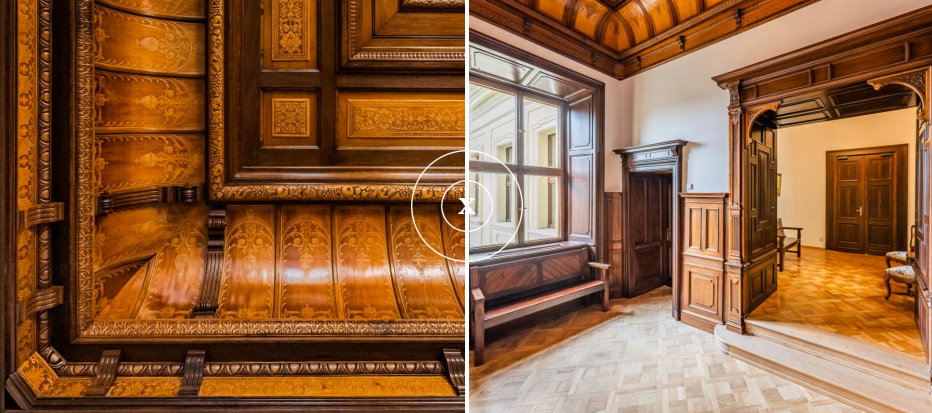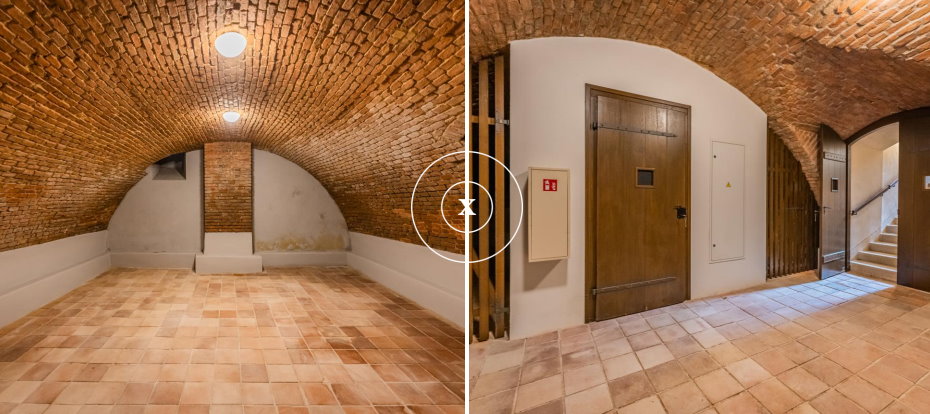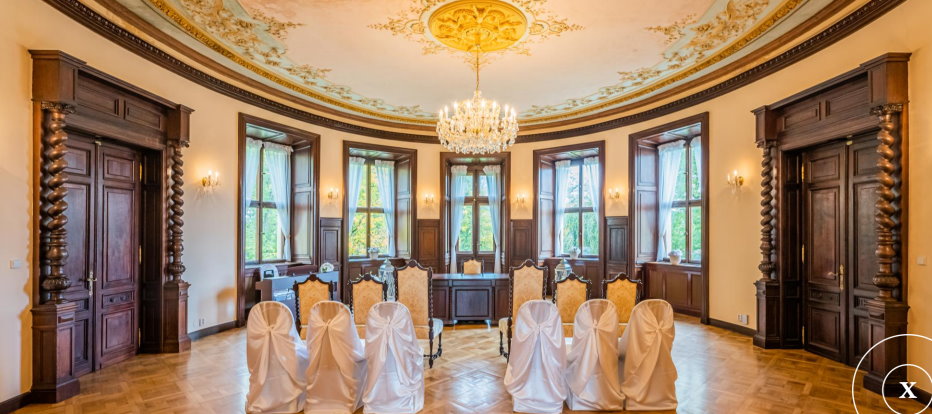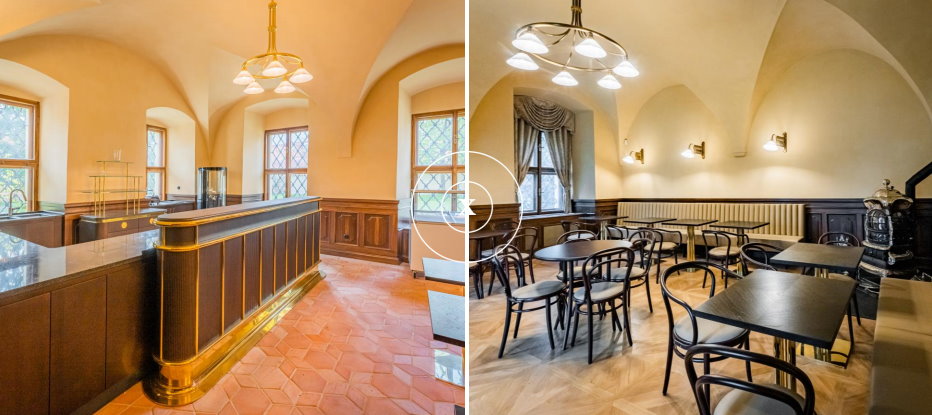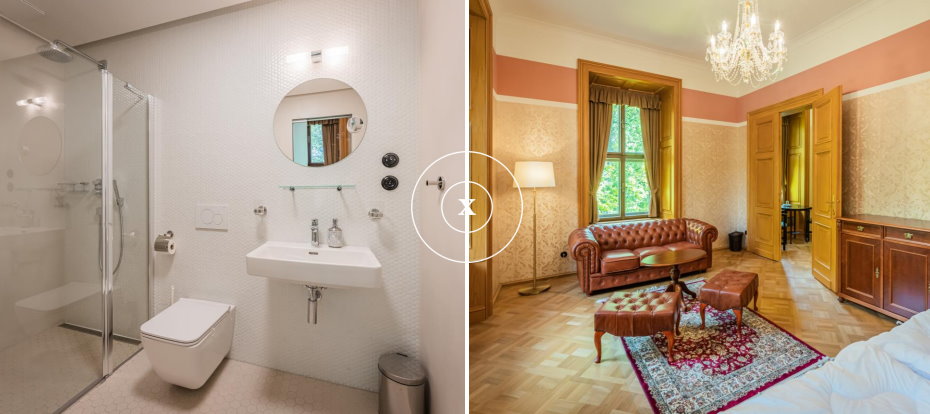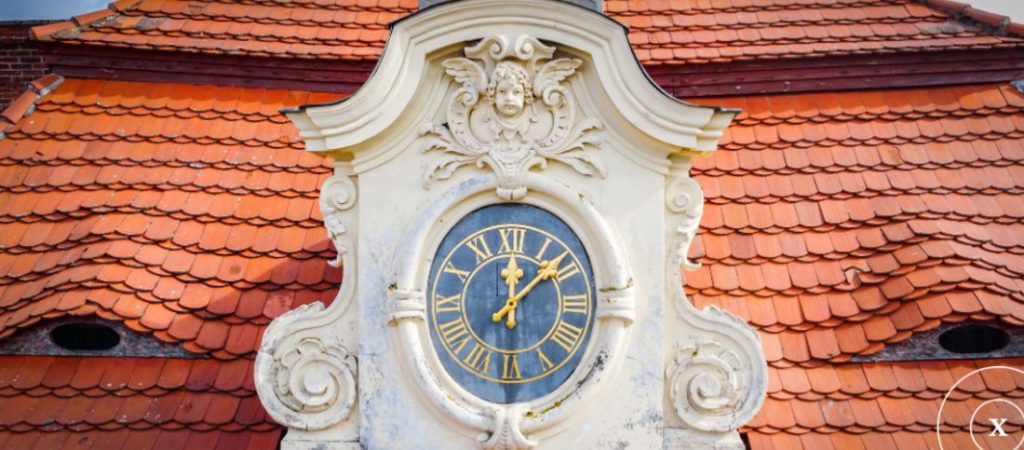€POA Mirosov, CZECHIA. Baroque Chateau For Sale
Castle Mirosov is a stunning, renovated Baroque Chateau for sale with Lenka Munter, Luxent Exclusive Properties.
Castle and grounds with adjacent land
Agent's Description
The distinctive dominant feature of the town of Mirošov, situated less than ten kilometers from Rokycany, is a breathtaking Baroque chateau built in 1719-1723 on the site of an original Renaissance fortress. The entrance courtyard of the chateau is decorated with a fountain located in front of the entrance, with carefully treated roads and flower beds lined by ornamental shrubs. The far side of the building adjoins the English park with mature trees. The chateau and garden area is protected by an enclosure wall with an entrance gate and two smaller side gates. Behind the building on the right side lies a farmyard with two buildings of a former brewery as well as a residential house with three apartments and utility rooms. The homestead also includes a granary (3 floors of 1.000 m2 and a cellar of 200 m2), which is located on the left side of the castle fence. The castle properties with adjacent land 5 hectares are suitable for both private housing and business.
The chateau itself is a one-story building with a northern wing built onto the foundations of the original Renaissance residence. We enter the central ground floor through wide massive oak doors. The entrance vestibule (112 m2) is lined with carved wood. The walls are lined with wooden plates decorated with simple motifs drawing from Gothic morphology. The hall that abuts the the garden extends into a spacious oval with a arched vault. The two-wing gate at the forefront of this oval leads into the castle park. The opposite (narrower) part of the vestibule is crowned by a barrel vault. The floor is paved with oak blocks set in the sand. The ground floor of the main building has vaulted ceilings; the first floor has flat ceilings.
On the right side of the vaulted entrance hall is the staircase to the first floor and entrances to both wings. One wing has four rooms with vaulted ceilings. The other has two rooms for castle operations as well as toilets.
Leading from the ground floor to the first floor are wooden staircases lined by balustrade railings. Window niches and indented windowsills are equipped with wooden carvings. Between the entrance to the oval hall and the entrance to the adjacent room is a mirror behind which hides a slim spiral staircase, a secret entrance to the rooms in the tower (77 m2). This first-floor landing above the staircase leads to seven rooms and the main representative hall (75 m2), which is located directly above the ground floor in an oval bay. We can enter it through three doors from neighboring rooms and halls. The door is set in richly carved woodcraft, a high point of the social elegance of the castle. The flat ceiling of the hall has rich embossed stucco decoration. A glazed door leads to a balcony lined with stone balustrades overlooking the castle park.
The floors in the rooms are made of parquet cassettes with chessboard patterns from various shades of oak. On the ground floor and in most rooms on the first floor, wooden flooring has been preserved. In five rooms upstairs, breathtaking cassette ceilings imitating the Italian Renaissance decor have been preserved.
The entire northern wing of the chateau underwent a complete reconstruction a few years ago. It is accessible not only by internal doors connected to the main building but also by a separate entrance from the courtyard. In this wing, the original Renaissance cellars with an area of 114.9 m2 have been preserved. They can serve as a wine shop or bar. On the ground floor the owner built a stylish café and bar (86 m2), as well as toilets and two apartments of 31 m2 and 26 m2. Four apartments of 42 m2, 41 m2, 29 m2 and 40 m2 were created on the first floor. These six apartments are fully equipped.
Two farm buildings, a brewery, and a brewery administrative structure were built later than the chateau, in 1749. The brewery was in operation until 1927. The longer wall of the brewery (50 m) is an extension of the enclosure wall of the chateau complex and separates it from Mirošov Square. The first above-ground floor of the brewery is vaulted, the second floor has flat ceilings. The total internal area is 1,000 m2. The one-story building of the administrator (253 m2) is connected at right angles and is accessible by passing to the brewery. This administrative building is single-story with a full basement. The cellars with a total area of 276 m2 can be reached from the passage along a spiral staircase. Interestingly, the cellars have more than 5.5 m at the highest point of the arcs and create monumental connected areas.
The house with two residential units behind the side gate of the castle park is located in a large garden with a natural pond. The house underwent a full reconstruction completed in 2020. There are two housing units 4+1 (84 m2), 5kk (129 m2). In this house there are also garages, workshops, laundry and warehouses with a total area of 174 m2.
To the chateau area with an area of area 48.651 m2 we offer in addition a great tract land in the Rokycany district with a total area of 380 ha. These lands include fields, forests and ponds.
The town of Mirošov lies in a charming undulating landscape between Prague and Plzen, directly on the border of the Brdy forest surrounded by beautiful nature and interesting historical monuments. The location is less than an hour driving by car from Prague on the D5 motorway towards Plzeň. It uses the benefits of the proximity of two large cities, Prague and Plzen, while surrounded by nature enables sports (cycling, hiking trails, mushrooming), or even a visit to important monuments (Kozel, Zbiroh, Nebílovy, Hořovice).
*Architecture*
The current Baroque castle was built on the site of a Renaissance fort, a one-story structure with a partial cellar. The building has a slightly irregular rectangular plan measuring 16 x 20 m. This original building was probably not fortified with earthen fortifications. It was actually a small castle, but according to the customs of the time it was still called a fortress. Later reconstructions erased the purely Renaissance character of the building, but its internal structure retained its original layout. The ground floor is divided longitudinally into two long tracts, northern and southern, which were further divided transversely into individual rooms. In the central part of the southern tract, the original staircase topped by a flattened cross vault with mortar crests has been preserved. The barrel-vaulted cellar is also Renaissance.
Later, during the construction of the Baroque castle, this entire original Renaissance fort was integrated into the whole and became the northern wing of the castle. The new Baroque castle was connected to its southern facade by a short section. The original building was modified in the Baroque style to match the style of the new structure. The castle's one-story rectangular new building with dimensions of 30 x 16 m is covered with a mansard roof with a turret. This is when the current visage of the castle emerged. The facades are optically divided by moldings and the rectangular windows are decorated with profiled jambs and wavy pediments. The western entrance facade with a raised-elevation attic is decorated with an openwork cornice, under which the stone alliance emblem of the builders – Jan Antonín Vratislav from Mitrovic and Maria Zuzana Talacková from Ještětice – is placed in the area of the low triangular gable. Atlantean sculptures on both sides of the entrance portal support a balcony. The eastern facade facing the castle park is decorated with a portal with Ionic columns supporting a balcony with a balustrade railing. The park is entered through this portal from the oval-shaped ground floor hall. The ground floor of the castle is vaulted, the first floor has a flat ceiling with rooms decorated with wooden cassettes or stucco frames. During the thoroughgoing reconstruction, which took place between 1893 and 1897, the residence was provided with new facades, interiors were decorated with exquisite carved wooden ceilings, and furniture was built into four rooms on the first floor of the castle and in one room in the north wing. New doors were made, the walls were covered with carved wood and wallpapering in neo-rococo style. From the time of the German seizure of the property and then the communist expropriation, the castle was damaged and then began to decay. From 1991, after the castle was returned to the descendants of the last private owner, further expensive reconstructions began, which continued even after the sale to the current owner. Renovation of stone elements at the entrances of the castle took place, facades were rebuilt, all wooden elements were completely restored (repair of windows, renovation of oak floors, paneling of walls and carved ceilings). A fountain was installed again in front of the castle and the demolished wall of the castle park was rebuilt. A complete and expensive reconstruction of the northern wing took place, which created a cafe, toilets and six completely furnished new apartments for the accommodation of guests and a renovated Renaissance cellar.
The grounds of the castle with the park are protected by an enclosure wall with a baroque pillar gate and two smaller side gates. Previously, the castle courtyard was accessed through a gate in the wall separating the castle land from the center of the town of Mirošov. It was later walled up. Today's entrance, in the northwest corner of the courtyard, is of more recent origin.
History
The castle at Mirosov mostlikely dates back to the first half of the 16th century.
At that time, Ferdinand Gryspek from Gryspach first built a renaissance fort on the current site. Because he died without heirs, his brother sold the property at the beginning of the 17th century to Adam Vratislav of Mitrovic. Adam Vratislav’s grandson Jan Antonin was ennobled to the rank of count, and with this ennoblement, began to build a prestigious residence. In building the present baroque chateau he fell into debt and the property was taken into court administration. In 1725 the property was bought in auction by the Imperial Court Chamber. The chateau was at that time empty and dilapidated, with numerous broken windows. The new manager of the estate organized repairs, and added apartments and an office to the chateau. In 1834 the chateau became the seat of the Imperial Mining Administration which also used the premises as apartments and offices. From 1868 to 1890 there were several changes of ownership after which the estate was bought by the Mirošov Coal Mining Company, whose long-serving director was Jan Fitz. At that time (from 1893 to 1897) the chateau was thoroughly repaired at great expense. This included a new façade and roof, wooden inlayed ceilings, doors and wooden paneling. Fitz later bought the property from the mining company. After his death Max Maendl bought the estate in a public auction. Maendlś son Josef continued to manage the property after him, but in 1939, since he was Jewish, with the threat of German Fascism, he sold the property to Dr. Ladislav Feierabend and fled abroad. In 1940 Dr. Feierabend, an economist and politician, was himself forced to escape abroad when his role in the resistance movement was uncovered and his arrest by the Gestapo was imminent. He managed to get to England where he became minister of finance in President Benešś Government in exile. After the liberation of Czechoslovakia in 1945, Dr. Feierabend returned to the republic and began to manage his estate in Mirošov again. But after the communist putsch in February 1948 he was forced once more into exile – this time taking his family with him, and narrowly avoiding arrest by the communist secret police. The state seized the property, and in 1952 the management of Mirošov chateau with its estate was taken over by the Czechosloovak State Farm Institution. The interior of the chateau was again converted into flats and offices, as well as a kitchen and refectory for employees. At the beginning of the 1970’s the chateau was transferred to the ownership of the Customs Office, which wanted to establish a trainng centre here. Soon, however, construction could not be sustained and the Customs Office eventually abandoned its plan – not, unfortunately, before the chateau was damaged by ill-conceived attempts at reconstruction. The chateau then remained abandoned until 1991 when it was restituted to the family of Dr. Feierabend. The repairs began at that time, and were continued by the present owner when he purchased the property in 2015.'


